Potato flour is a versatile ingredient that adds a unique texture and flavor to many dishes, from bread to pancakes and beyond.
However, it can be challenging to find in some grocery stores, and some individuals may have dietary restrictions that prevent them from using it.
Fortunately, there are several potato flour substitutes available that can help you achieve similar results in your cooking and baking.
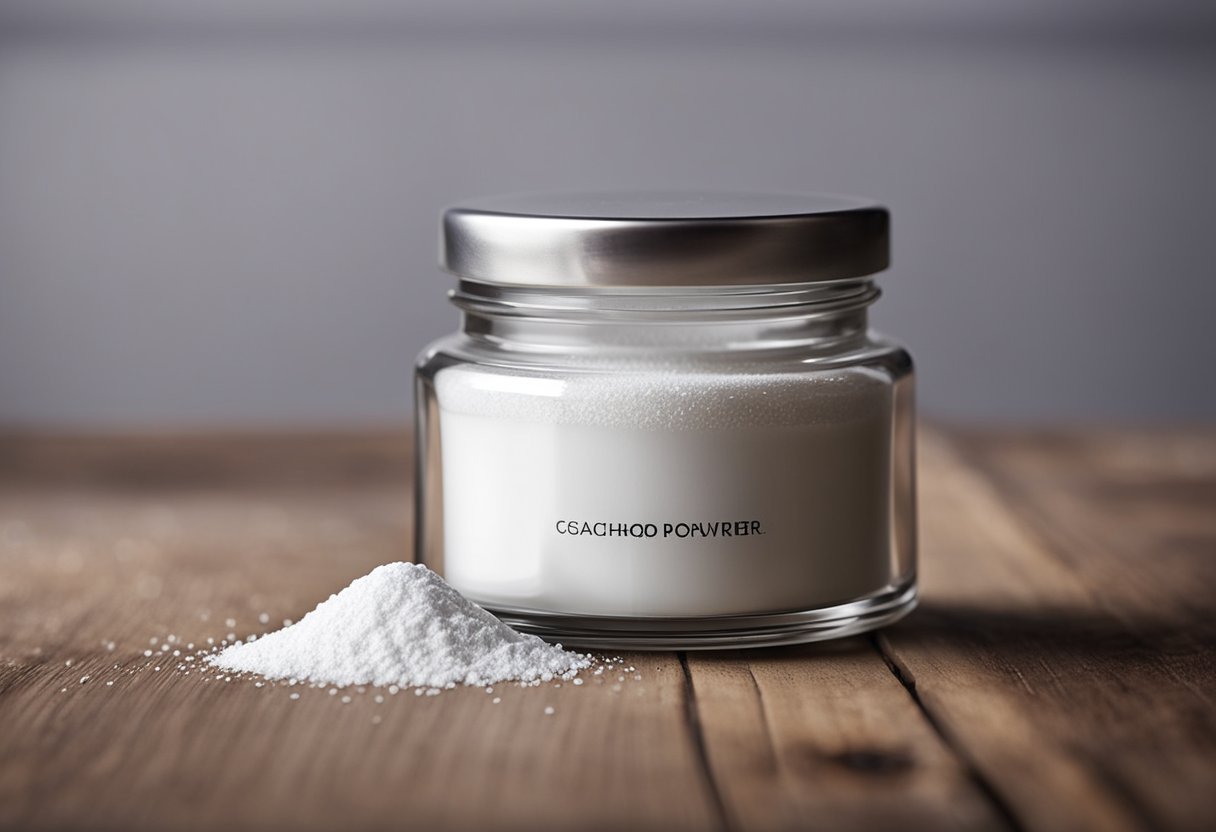
Understanding the properties of potato flour can help you choose the right substitute for your recipe. Potato flour is made from dehydrated potatoes that have been ground into a fine powder.
It is high in starch and has a distinctive flavor that can be slightly sweet or earthy, depending on the variety. Potato flour is commonly used in gluten-free baking because it helps to bind ingredients together and create a moist, tender texture.
However, it is not the same as potato starch, which is a more refined product that is often used as a thickener in soups and sauces.
Key Takeaways
- Potato flour is a versatile ingredient, but it can be difficult to find and may not be suitable for everyone’s dietary needs.
- Several potato flour substitutes are available, including cornstarch, tapioca flour, arrowroot, rice flour, and mashed potatoes.
- When choosing a substitute, consider the properties of the original recipe and the desired outcome, and experiment with different options to find the best fit.
Understanding Potato Flour
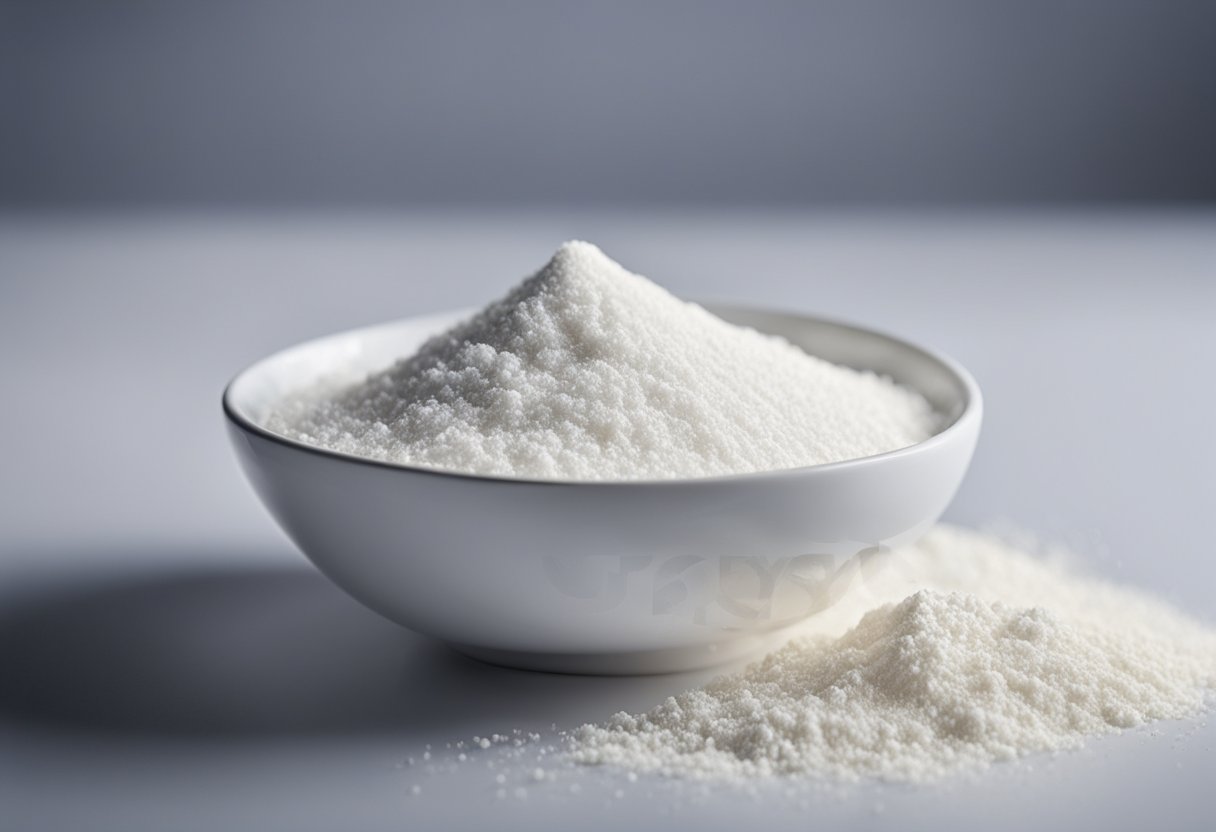
As a baker, I have come across different types of flour, and one that I have found to be quite unique is potato flour.
Potato flour is made from whole potatoes that are cooked, dried, and ground into a fine powder. It is gluten-free and has a unique flavor and texture that sets it apart from other flours.
One of the main characteristics of potato flour is its flavor. It has a subtle potato taste that can add depth to baked goods.
However, it is important to note that its flavor can be overpowering if used in excess. So, it is best to use it in moderation or in combination with other flours to balance out the flavor.
Another characteristic of potato flour is its texture. It is a fine powder that can be used to add moisture to baked goods. It also has a high starch content, which makes it a great thickening agent for sauces and gravies.
Potato flour is also a great source of starch, which is a complex carbohydrate that provides energy to the body.
It is also rich in vitamins and minerals such as potassium, vitamin C, and vitamin B6, making it a healthier option compared to other flours.
In summary, potato flour is a unique and versatile flour that can add flavor, texture, and nutrition to baked goods.
However, it is important to use it in moderation and in combination with other flours to balance out its flavor and texture. Its high starch content also makes it a great thickening agent for sauces and gravies.
Why Substitute Potato Flour
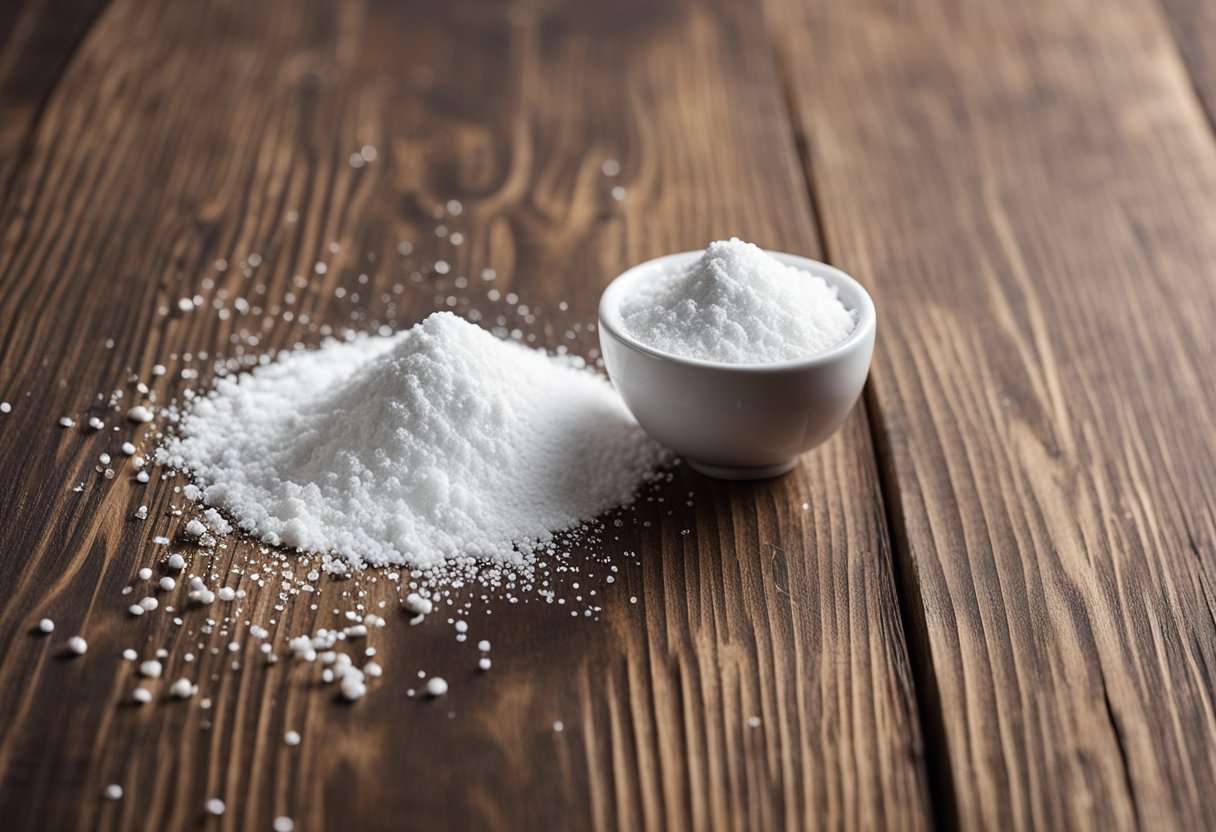
As a baker and cook, I understand the importance of having the right ingredients for a recipe. However, sometimes it can be challenging to find specific ingredients, such as potato flour.
Luckily, there are several potato flour substitutes that can be used in baking and cooking.
Substituting potato flour can be necessary for several reasons. For example, you may have a recipe that requires potato flour, but you cannot find it at your local grocery store.
Or, you may have a guest with a potato allergy or intolerance, and you need to find a replacement ingredient.
Another reason to substitute potato flour is that it can be expensive and not readily available in all areas. By using a substitute, you can save money and still achieve the same results in your recipe.
Some common substitutes for potato flour include cornstarch, rice flour, and tapioca flour. These substitutes can be used in equal amounts as potato flour in recipes.
However, it is essential to keep in mind that each substitute may alter the taste and texture of the final product.
One of my favorite substitutes for potato flour is mashed potato. Mashed potato can be used in place of potato flour in many recipes, such as bread and pancakes.
It adds moisture and a subtle potato flavor to the finished product.
In conclusion, there are several reasons why you may need to substitute potato flour in your recipes. Luckily, there are many substitutes available that can be used in equal amounts.
By experimenting with different substitutes, you can find the perfect replacement for your recipe.
Types of Potato Flour Substitutes
When it comes to potato flour substitutes, there are several options available. Here are some of the most common substitutes and how they can be used:
- Potato Starch: Potato starch is a good substitute for potato flour in recipes that require a thickener. It has a similar texture and can be used in equal amounts as a substitute for potato flour.
- Cornstarch: Cornstarch is another good substitute for potato flour. It has a similar texture and can be used in equal amounts as a substitute for potato flour.
- Rice Flour: Rice flour is a gluten-free substitute for potato flour. It has a slightly different texture than potato flour, but can be used in equal amounts in most recipes.
- Arrowroot: Arrowroot is a good substitute for potato flour in recipes that require a thickener. It has a similar texture and can be used in equal amounts as a substitute for potato flour.
- All-Purpose Flour: All-purpose flour can be used as a substitute for potato flour in recipes that require a thickener. However, it is important to note that all-purpose flour contains gluten, so it may not be suitable for those with gluten sensitivities.
- Tapioca Flour: Tapioca flour is a gluten-free substitute for potato flour. It has a similar texture and can be used in equal amounts in most recipes.
- Wheat Flour: Wheat flour can be used as a substitute for potato flour in recipes that require a thickener. However, it is important to note that wheat flour contains gluten, so it may not be suitable for those with gluten sensitivities.
- Oca Flour: Oca flour is a gluten-free substitute for potato flour. It has a similar texture and can be used in equal amounts in most recipes.
- Quinoa Flour: Quinoa flour is a gluten-free substitute for potato flour. It has a slightly different texture than potato flour, but can be used in equal amounts in most recipes.
- Arrowroot Powder: Arrowroot powder is a good substitute for potato flour in recipes that require a thickener. It has a similar texture and can be used in equal amounts as a substitute for potato flour.
- Whole Wheat/Bread Flour: Whole wheat or bread flour can be used as a substitute for potato flour in recipes that require a thickener. However, it is important to note that these flours contain gluten, so they may not be suitable for those with gluten sensitivities.
- Coconut Flour: Coconut flour is a gluten-free substitute for potato flour. It has a slightly different texture than potato flour, but can be used in equal amounts in most recipes.
- Sweet Potato Flour: Sweet potato flour is a gluten-free substitute for potato flour. It has a slightly different texture than potato flour, but can be used in equal amounts in most recipes.
- Cassava Flour: Cassava flour is a gluten-free substitute for potato flour. It has a similar texture and can be used in equal amounts in most recipes.
Overall, there are many potato flour substitutes available that can be used in a variety of recipes.
It is important to choose the appropriate substitute based on the recipe and any dietary restrictions.
Using Substitutes in Different Recipes
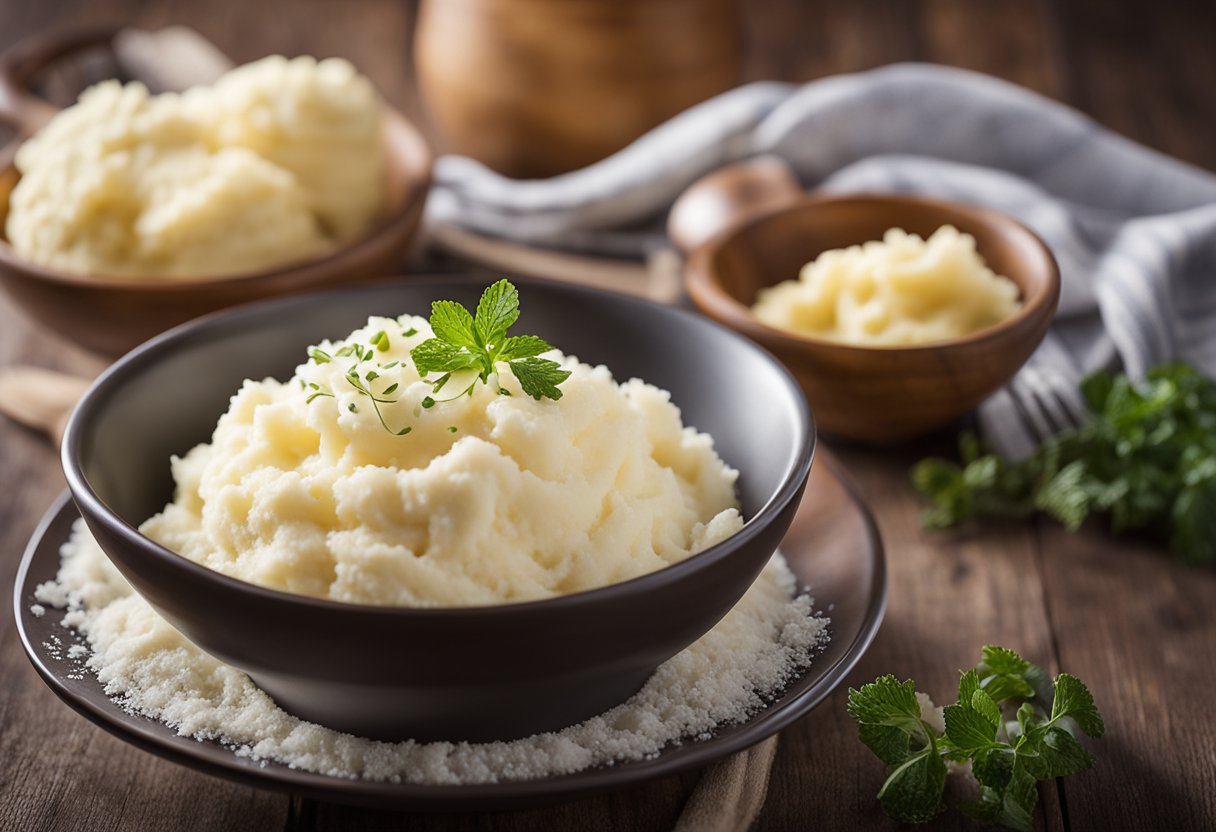
When it comes to using substitutes for potato flour in different recipes, it’s important to keep in mind the specific characteristics of the original ingredient and how it contributes to the final product.
Here are some tips for using potato flour substitutes in various recipes:
Baking Recipes
In baking recipes, potato flour is often used as a thickening agent or to add moisture to the dough. Cornstarch, tapioca flour, and arrowroot are all good substitutes for potato flour in baked goods.
Rice flour and quinoa flour can also be used, but they may result in a slightly grainy texture. Mashed potatoes can be a great substitute as well, especially in bread baking.
When using mashed potatoes, it’s important to adjust the liquid content of the recipe accordingly.
Soups, Stews, and Sauces
In soups, stews, and sauces, potato flour is often used as a thickener. Cornstarch, arrowroot, and tapioca flour are all good substitutes for potato flour in these recipes.
When using cornstarch, it’s important to mix it with cold water before adding it to the hot liquid to prevent clumping.
Fried Foods
Potato flour is often used in fried foods to create a crispy coating. Rice flour and cornstarch can be used as substitutes for potato flour in these recipes. When using rice flour, it’s important to use a finer grind to avoid a gritty texture.
Chinese Cuisine
Potato flour is often used in Chinese cuisine as a thickener and to add moisture to dishes. Cornstarch and tapioca flour are good substitutes for potato flour in these recipes.
When using cornstarch, it’s important to mix it with cold water before adding it to the hot liquid to prevent clumping.
Raw Potatoes vs. Cooked Potatoes
When substituting potato flour with mashed potatoes, it’s important to use cooked potatoes rather than raw potatoes. Raw potatoes contain enzymes that can break down gluten in dough, resulting in a sticky and difficult-to-work-with dough.
Overall, there are many good substitutes for potato flour in various recipes.
By keeping in mind the specific characteristics of the original ingredient and how it contributes to the final product, it’s possible to create delicious dishes using alternative ingredients.
Considerations for Dietary Restrictions
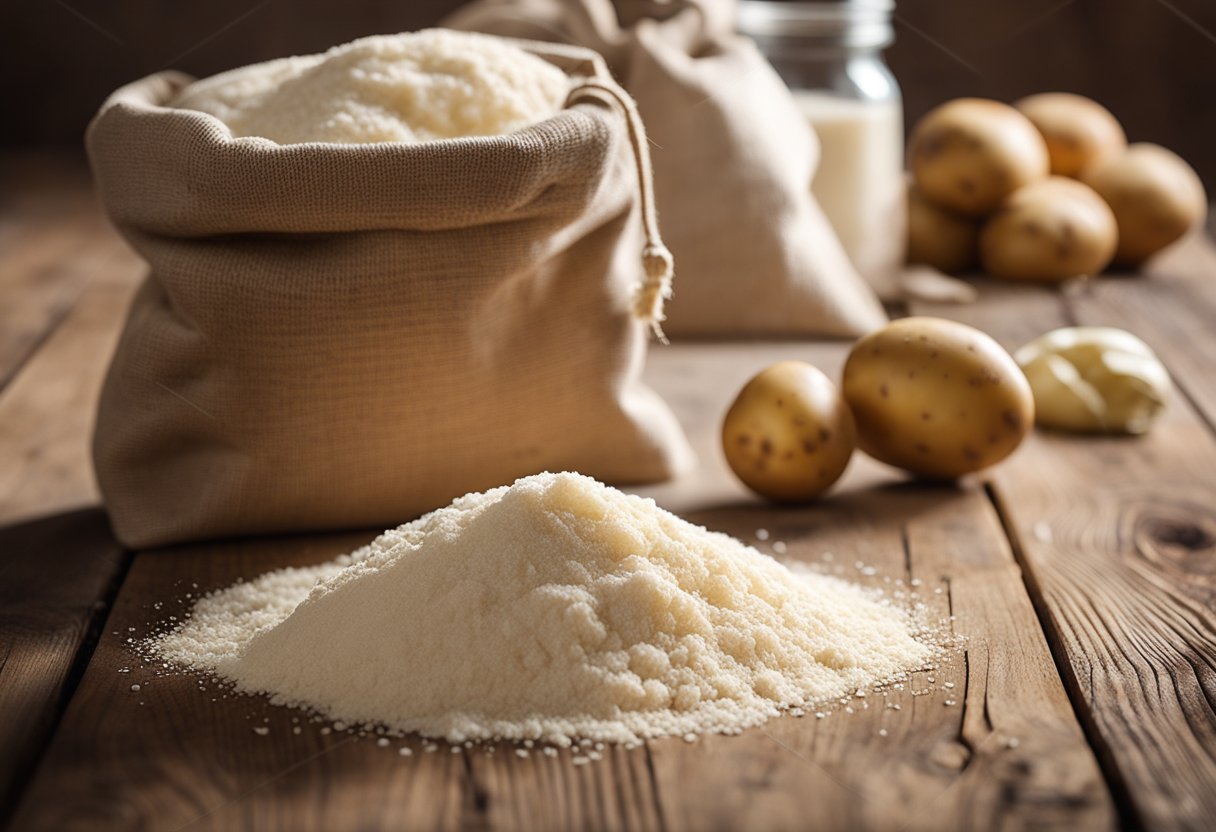
As someone who has dietary restrictions, finding the right potato flour substitute can be challenging.
However, there are several options available that cater to different dietary needs. Here are some considerations for those with dietary restrictions:
Gluten-Free
If you have celiac disease or a gluten intolerance, you’ll want to avoid potato flour substitutes that contain gluten.
Rice flour, cornstarch, and tapioca flour are excellent gluten-free alternatives to potato flour. These substitutes have a similar texture to potato flour and can be used in the same quantities.
Potato Flakes
If you’re looking for a potato flour substitute that has a similar flavor to potato flour, potato flakes are an excellent option. Potato flakes are made from dehydrated potatoes and can be used in place of potato flour in most recipes.
However, keep in mind that potato flakes have a coarser texture than potato flour, so you may need to adjust the recipe to get the desired texture.
Vegan
If you’re following a vegan diet, you’ll want to avoid potato flour substitutes that contain animal products. Rice flour, cornstarch, and tapioca flour are all vegan-friendly alternatives to potato flour.
Additionally, chickpea flour, lentil flour, and pea flour are excellent legume-based substitutes that are also vegan.
Gluten-Free Diet
If you’re on a gluten-free diet, you’ll want to avoid potato flour substitutes that contain gluten. Rice flour, cornstarch, and tapioca flour are all excellent gluten-free alternatives to potato flour.
Additionally, almond flour, coconut flour, and sorghum flour are all gluten-free alternatives that can be used in place of potato flour.
Kosher
If you follow a kosher diet, you’ll want to make sure that your potato flour substitute is kosher-certified. Rice flour, cornstarch, and tapioca flour are all kosher-certified alternatives to potato flour.
Additionally, almond flour, coconut flour, and sorghum flour are all kosher-certified alternatives that can be used in place of potato flour.
Overall, there are several potato flour substitutes available that cater to different dietary needs. By understanding your dietary restrictions and goals, you can determine which substitute is right for you.
The Role of Substitutes in Baking
As a baker, I often encounter situations where I need to substitute an ingredient. Substitutes play an important role in baking because they allow us to adjust recipes to our preferences or to work with what we have on hand.
In this section, I will discuss the role of substitutes in baking, specifically in relation to potato flour.
One of the most common reasons for substituting ingredients in baking is to adjust the moisture content. Moisture is essential in baking because it helps to create a tender and moist crumb.
However, too much moisture can cause a cake or bread to become dense and heavy. When substituting for potato flour, it is important to consider the moisture content of the substitute.
For example, cornstarch is a good substitute for potato flour, but it does not add moisture to a recipe.
Starch is another important factor to consider when substituting ingredients in baking. Starch helps to provide structure and stability to baked goods.
Potato flour is high in starch, so when substituting, it is important to choose a substitute with a similar starch content.
Tapioca flour and arrowroot are good substitutes for potato flour because they are also high in starch.
Color is another factor to consider when substituting for potato flour. Potato flour has a slightly yellow color, which can affect the appearance of baked goods.
Cornstarch and rice flour are good substitutes for potato flour, but they are both white, so they may not be the best choice if you want to maintain the color of the original recipe.
Fiber and protein are two other factors to consider when substituting ingredients in baking. Potato flour is high in fiber and protein, so when substituting, it is important to choose a substitute with a similar nutritional profile.
Mashed potatoes are a good substitute for potato flour because they are also high in fiber and protein.
Lastly, additives and preservatives can also play a role in baking. Some substitutes may contain additives or preservatives that can affect the flavor or texture of baked goods.
It is important to read labels carefully and choose substitutes that are as natural as possible.
In conclusion, substitutes play an important role in baking, allowing us to adjust recipes to our preferences or to work with what we have on hand.
When substituting for potato flour, it is important to consider factors such as moisture, starch, color, fiber, protein, and additives.
By choosing the right substitute, you can ensure that your baked goods turn out just as delicious as the original recipe.
Nutritional Comparison of Substitutes

When it comes to substituting potato flour, it’s important to consider the nutritional value of the alternatives. Here’s a comparison of some common substitutes:
Cornstarch
Cornstarch is a great substitute for potato flour when it comes to thickening sauces and gravies. However, it lacks the nutritional value of potato flour.
Cornstarch is low in fiber and protein and is mainly composed of carbohydrates. It has a neutral flavor and does not add any sweetness to the dish.
Tapioca Flour
Tapioca flour is another popular substitute for potato flour. It has a similar texture and is also gluten-free.
However, tapioca flour is low in fiber and protein and is mainly composed of carbohydrates. It has a neutral flavor and does not add any sweetness to the dish.
Arrowroot Powder
Arrowroot powder is a good substitute for potato flour when it comes to thickening sauces and gravies. It has a neutral flavor and does not add any sweetness to the dish.
However, arrowroot powder is low in fiber and protein and is mainly composed of carbohydrates.
Rice Flour
Rice flour is a good substitute for potato flour when it comes to baking. It has a similar texture and is also gluten-free.
However, rice flour is low in fiber and protein and is mainly composed of carbohydrates. It has a neutral flavor and does not add any sweetness to the dish.
Quinoa Flour
Quinoa flour is a healthy substitute for potato flour. It is high in protein and fiber and has a neutral flavor. It can be used in baking and thickening sauces and gravies.
Mashed Potatoes
Mashed potatoes are a good substitute for potato flour when it comes to adding moisture to a dish. They have a similar texture and add a subtle potato flavor to the dish.
However, mashed potatoes are not gluten-free and are higher in calories than potato flour.
Overall, it’s important to consider the nutritional value and flavor of the substitutes when choosing a potato flour substitute. While some substitutes may have a similar texture, they may lack the nutritional value of potato flour.
Finding Substitutes at the Grocery Store
As someone who loves to cook and bake, I know how frustrating it can be when you don’t have a key ingredient on hand.
Fortunately, there are plenty of potato flour substitutes available at your local grocery store. Here are a few options to consider:
Cornstarch
Cornstarch is a popular substitute for potato flour. It’s easy to find in the baking aisle of most grocery stores, and it works well as a thickener in sauces and gravies.
When using cornstarch as a substitute for potato flour, keep in mind that it has a higher starch content, so you may need to use less of it.
Tapioca Flour
Tapioca flour is another great option if you’re looking for a potato flour substitute. It’s made from the root of the cassava plant and has a similar texture to potato flour.
You can find tapioca flour in the gluten-free section of most grocery stores.
Rice Flour
Rice flour is a versatile substitute for potato flour. It’s made from ground rice and can be used in a variety of recipes, including breads, cakes, and cookies. Look for rice flour in the baking aisle of your grocery store.
Quinoa Flour
Quinoa flour is a nutritious substitute for potato flour. It’s high in protein and fiber and has a nutty flavor that works well in baked goods. You can find quinoa flour in the health food section of most grocery stores.
Mashed Potatoes
If you don’t have any potato flour substitutes on hand, you can always use mashed potatoes as a substitute. Simply boil some potatoes, mash them up, and use them in place of the potato flour.
Keep in mind that this may affect the texture and flavor of your recipe.
In conclusion, there are plenty of potato flour substitutes available at your local grocery store.
Whether you choose cornstarch, tapioca flour, rice flour, quinoa flour, or mashed potatoes, you’re sure to find a substitute that works well in your recipe.
Making Your Own Substitutes
As a chef, I often find myself in situations where I need to substitute potato flour in a recipe due to dietary restrictions or simply because I don’t have any on hand.
Luckily, there are several substitutes that can be easily made at home.
One of the easiest substitutes for potato flour is mashed potatoes. Simply cook and mash a potato until it is smooth and use it in place of the potato flour.
This substitute works well in recipes that require a small amount of potato flour, such as in sauces or gravies.
Another option is to use potato starch, which is made from raw potatoes that have been washed, peeled, and grated.
The grated potatoes are then soaked in water, and the starch is separated from the liquid. This starch can be used in place of potato flour in recipes that require a thickener.
If you don’t have any potatoes on hand, there are other substitutes that can be used. Cornstarch, tapioca flour, and arrowroot powder can all be used in place of potato flour in recipes that require a thickener.
These substitutes work best when mixed with a liquid and heated to thicken.
Potato flakes can also be used as a substitute for potato flour. Simply rehydrate the flakes with a small amount of liquid and use them in place of the flour.
This substitute works well in recipes that require a larger amount of potato flour, such as in bread or pancakes.
If you have a dehydrator, you can make your own potato flour by dehydrating cooked potatoes and then grinding them into a fine powder. This homemade potato flour can be used in any recipe that calls for potato flour.
In summary, there are several substitutes for potato flour that can be easily made at home.
Mashed potatoes, potato starch, cornstarch, tapioca flour, arrowroot powder, potato flakes, and homemade potato flour are all great options to use in place of potato flour in recipes.
Frequently Asked Questions
What are some common substitutes for potato flour in baking?
If you don’t have potato flour on hand, there are several other flours that can be used as a substitute. Some common substitutes for potato flour include cornstarch, tapioca flour, rice flour, and arrowroot flour.
Each of these flours has a slightly different texture and flavor, so you may need to experiment to find the best substitute for your recipe.
Can potato starch be used as a substitute for potato flour?
While potato starch and potato flour are made from the same vegetable, they are not interchangeable in recipes. Potato starch is a fine, white powder that is primarily used as a thickener in sauces and soups.
Potato flour, on the other hand, is made from the whole potato and has a denser texture.
While potato starch can be used as a substitute for cornstarch or arrowroot flour in some recipes, it is not a good substitute for potato flour in baking.
How does potato flour differ from wheat flour in baking?
Potato flour and wheat flour have different properties when it comes to baking. Wheat flour contains gluten, which gives bread dough its elasticity and helps it rise.
Potato flour, on the other hand, is gluten-free and has a denser texture. When baking with potato flour, you may need to add additional gluten-free ingredients, such as xanthan gum, to help your dough rise properly.
Where can I find potato flour for purchase?
Potato flour can usually be found in the baking section of most grocery stores. If you can’t find it at your local store, you can also purchase it online from a variety of retailers.
When purchasing potato flour, be sure to check the label to make sure it is gluten-free if that is a concern for you.
What is the role of potato flour in bread making?
Potato flour is often used in bread making to add moisture and improve the texture of the bread. It also helps to extend the shelf life of the bread by keeping it moist.
When using potato flour in bread recipes, it is important to follow the recipe carefully to ensure that the dough rises properly.
What are some alternatives to using potato flour in Chinese cooking?
Potato flour is often used in Chinese cooking as a thickener for sauces and soups. If you don’t have potato flour on hand, you can use cornstarch or tapioca starch as a substitute.
Simply mix the starch with water to create a slurry, and then add it to your dish to thicken the sauce. Be sure to add the slurry slowly and stir constantly to prevent lumps from forming.







